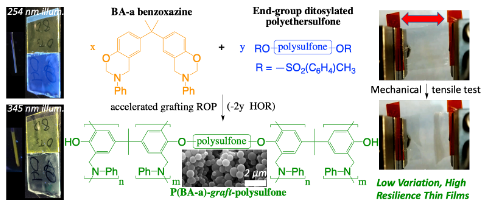Research Proj 1- Advanced Polymers for Aerospace

Many aerospace composites structures are constructed from sandwich panels that include two phenolic/fiberglass composite skins on either side of a honeycomb core (as shown at right). “Crush core compression molding” cures the semi-polymerized phenol-formaldehyde (PF) or phenolic polymer in the composite skins and sets the geometry and mechanical properties of the part.

In 2008, the European Union Committee established to define Environmental Health and Safety made a recommendation that phenol-based polymers be phased out in the next generation of composites. A collaboration between a Washington aerospace industrial partner and the Departments of Engineering and Chemistry at Western Washington University has been charged to investigate alternative materials for next generation composites. The alternative material is expected to match many of the material and processing characteristics of the phenol-based material and enable long-term opportunities for greener processing.
Polybenzoxazines, (PBOs) display excellent properties such as near-zero volumetric cure shrinkage, high glass transition temperatures, low flammability, low water absorption and tunable thermal and mechanical properties and have had demonstrated success in the aerospace and microelectronics industries. In 2017, our group discovered that solubilizing a benzoxazine monomer in reactive end-group tosylated polyethyleneglycols (PEGs) leads to a thermoset resin with a reduced cure temperature (by up to 75°C) and affords a new graft copolymer that is more stable than the parent P(BA-a) or its analogue blends made without the tosylated polymers. It follows therefore that previously unattainable characteristics can be realized from the grafting TROP of benzoxazines blended with these reactive polymers and particles. The project will study the new range of hybridized materials afforded from a recently discovered grafting polymerization reaction for blended benzoxazine monomers and sulfonyl ester-functionalized materials. A major objective of the work is to understand the fundamental chemistry and polymer science of this grafting thermal ring opening polymerization (grafting TROP) reaction and to elucidate the bonding in the hybridized products.

See our paper in: Macromolecules.
https://doi.org/10.1021/acs.macromol.1c01613
See our collaborative paper in: Journal of Polymer Science, Part A: Polymer Chemistry.
https://doi.org/10.1002/pola.29244
See our paper in: Macromolecules.
http://dx.doi.org/10.1021/acs.macromol.7b01457
See our paper in: Industrial & Engineering Chemistry Research.
http://pubs.acs.org/doi/abs/10.1021/acs.iecr.5b02852
See a video highlight of this work here:
https://youtu.be/qKJAdt0tK30
https://jcati.org/videos/development-fasteners-and-composites-aerospace-industry

